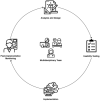Human-centered development of an electronic health record-embedded, interactive information visualization in the emergency department using fast healthcare interoperability resources
- PMID: 33682004
- PMCID: PMC8279791
- DOI: 10.1093/jamia/ocab016
Human-centered development of an electronic health record-embedded, interactive information visualization in the emergency department using fast healthcare interoperability resources
Abstract
Objective: Develop and evaluate an interactive information visualization embedded within the electronic health record (EHR) by following human-centered design (HCD) processes and leveraging modern health information exchange standards.
Materials and methods: We applied an HCD process to develop a Fast Healthcare Interoperability Resources (FHIR) application that displays a patient's asthma history to clinicians in a pediatric emergency department. We performed a preimplementation comparative system evaluation to measure time on task, number of screens, information retrieval accuracy, cognitive load, user satisfaction, and perceived utility and usefulness. Application usage and system functionality were assessed using application logs and a postimplementation survey of end users.
Results: Usability testing of the Asthma Timeline Application demonstrated a statistically significant reduction in time on task (P < .001), number of screens (P < .001), and cognitive load (P < .001) for clinicians when compared to base EHR functionality. Postimplementation evaluation demonstrated reliable functionality and high user satisfaction.
Discussion: Following HCD processes to develop an application in the context of clinical operations/quality improvement is feasible. Our work also highlights the potential benefits and challenges associated with using internationally recognized data exchange standards as currently implemented.
Conclusion: Compared to standard EHR functionality, our visualization increased clinician efficiency when reviewing the charts of pediatric asthma patients. Application development efforts in an operational context should leverage existing health information exchange standards, such as FHIR, and evidence-based mixed methods approaches.
Keywords: clinical decision support systems; health information exchange; health information interoperability; human-centered design; implementation science.
© The Author(s) 2021. Published by Oxford University Press on behalf of the American Medical Informatics Association. All rights reserved. For permissions, please email: journals.permissions@oup.com.
Figures
Similar articles
-
Changes in Health Information Exchange Use Behavior After Introduction of a Fast Healthcare Interoperability Resources (FHIR) Application.AMIA Annu Symp Proc. 2025 May 22;2024:581-589. eCollection 2024. AMIA Annu Symp Proc. 2025. PMID: 40417487 Free PMC article.
-
Integrated displays to improve chronic disease management in ambulatory care: A SMART on FHIR application informed by mixed-methods user testing.J Am Med Inform Assoc. 2020 Aug 1;27(8):1225-1234. doi: 10.1093/jamia/ocaa099. J Am Med Inform Assoc. 2020. PMID: 32719880 Free PMC article.
-
Development of an application concerning fast healthcare interoperability resources based on standardized structured medical information exchange version 2 data.Comput Methods Programs Biomed. 2021 Sep;208:106232. doi: 10.1016/j.cmpb.2021.106232. Epub 2021 Jun 8. Comput Methods Programs Biomed. 2021. PMID: 34174764
-
A Blockchain Framework for Patient-Centered Health Records and Exchange (HealthChain): Evaluation and Proof-of-Concept Study.J Med Internet Res. 2019 Aug 31;21(8):e13592. doi: 10.2196/13592. J Med Internet Res. 2019. PMID: 31471959 Free PMC article. Review.
-
Musculoskeletal Disorder (MSD) Health Data Collection, Personalized Management and Exchange Using Fast Healthcare Interoperability Resources (FHIR).Sensors (Basel). 2024 Aug 10;24(16):5175. doi: 10.3390/s24165175. Sensors (Basel). 2024. PMID: 39204872 Free PMC article. Review.
Cited by
-
The influence of electronic health record design on usability and medication safety: systematic review.BMC Health Serv Res. 2025 Jan 6;25(1):31. doi: 10.1186/s12913-024-12060-2. BMC Health Serv Res. 2025. PMID: 39762805 Free PMC article.
-
Attention Among Health Care Professionals : A Scoping Review.Ann Intern Med. 2024 Jul;177(7):941-952. doi: 10.7326/M23-3229. Epub 2024 Jun 18. Ann Intern Med. 2024. PMID: 38885508 Free PMC article.
-
A systematic review of clinicians' acceptance and use of clinical decision support systems over time.NPJ Digit Med. 2025 May 26;8(1):309. doi: 10.1038/s41746-025-01662-7. NPJ Digit Med. 2025. PMID: 40419669 Free PMC article.
-
Electronic Health Record-Embedded, Behavioral Science-Informed System for Smoking Cessation for the Parents of Pediatric Patients.Appl Clin Inform. 2022 Mar;13(2):504-515. doi: 10.1055/s-0042-1748148. Epub 2022 May 18. Appl Clin Inform. 2022. PMID: 35584789 Free PMC article.
-
Machine Learning-Enabled Clinical Information Systems Using Fast Healthcare Interoperability Resources Data Standards: Scoping Review.JMIR Med Inform. 2023 Aug 24;11:e48297. doi: 10.2196/48297. JMIR Med Inform. 2023. PMID: 37646309 Free PMC article.
References
-
- Zhang J. The nature of external representations in problem solving. Cogn Sci 1997; 21 (2): 179–217.
-
- Wickens CD, Hollands JG, Banbury S, et al.Engineering psychology and human performance. Eng Psychol Hum Perform 2013; 4: 394–5.
MeSH terms
LinkOut - more resources
Full Text Sources
Other Literature Sources




